All Amazon sellers are there to get successful and earn more revenue than before this is why we are going to give you tips on how will you be able to expand your business internationally with Amazon marketplaces that have already acquired a potential customer base worldwide.
If you are already running your business on any Amazon marketplace then you are just one move away from unlocking top-tier global markets with your winning products and reaching more potential customers who are willing to try your products.
We are going to unveil all the tips regarding unlocking global markets with Amazon and inform you how much you can gain via selling globally.
How to Sell Internationally on Amazon?
All Amazon and non-Amazon sellers can open an Amazon account and sell internationally with Amazon global selling. We are going to guide you about everything related to Amazon global selling in this blog. Keep reading and scale your business globally.
What Is Amazon Global Selling?
As a business owner, you must know that it can be challenging to achieve recognition through conventional or e-commerce means when operating a business in a specific region of the world.
However, attaining global recognition can be even more difficult and may require a significant investment in marketing and ensuring a smooth supply chain. In some cases, it may even be impossible to achieve this level of recognition.
Amazon has opened up a significant opportunity for businesses like yours to expand globally without the need to establish a proper supply chain from scratch with Amazon’s global selling.
Moreover, Amazon’s global selling provides access to a vast potential customer base, which can greatly benefit your business.
Amazon’s global selling manages all your business operations from sorting your stock to delivering your products to the final customer in every marketplace.
How Does Amazon Global Selling Work?
As mentioned above Amazon’s global selling provides the whole supply chain process and you just need to list your products in all the marketplaces that Amazon has currently. So now you need to know how many Amazon marketplaces are there in which you can list your products.
Below are the Amazon Global Marketplaces,
| Americas | Europe | Asia-Pacific | Middle East |
| Amazon.com | Amazon.co.uk | Amazon.co.jp | Amazon.ae |
| Amazon.ca | Amazon.de | Amazon.in | Amazon.eg |
| Amazon.com.mx | Amazon.es | Amazon.com.au | Amazon.sa |
| Amazon.com.br | Amazon.fr | Amazon.sg | |
| Amazon.it | |||
| Amazon.nl | |||
| Amazon.pl | |||
| Amazon.se | |||
| Amazon.com.tr |
Amazon sellers can list their products in all the above regions and reach more potential audiences for their products.
Amazon’s global selling feature has already got you covered in terms of supply chain such as,
- Fulfillment by Amazon (FBA): This service allows businesses to store their products in Amazon’s warehouses and use Amazon’s logistics and delivery network to ship orders to customers.
- Inventory management: Amazon provides businesses with tools to manage their inventory levels, track product sales and returns, and forecast demand.
- Shipping and delivery: Amazon offers a variety of shipping options, including same-day and two-day delivery, and provides businesses with tools to track shipments and manage customer returns.
- Payment processing: Amazon allows businesses to process payments through its platform, including credit card payments, bank transfers, and gift cards.
- Analytics and reporting: Amazon provides businesses with data and analytics to help them monitor their sales performance, track customer behavior, and identify growth opportunities.
- Assist with Provider Network: Amazon global selling also has an approved provider network that can Amazon assists sellers with translation, tax, and compliance issues specific to that country.
As these main business operations are covered then you just need to make an account on Amazon list your products and then choose the regions where you would like to sell.
You do not need to worry about language as well. You just need to list your product in that specific region’s language as if you are going to list your products in Germany then you should list your product in the German language.
You can get help from local linguist experts who also understand how to craft listing content with SEO.
When you have listed your products on all marketplaces then you just need to send stock to the Amazon fulfillment center by creating a shipment from Amazon seller central.
Benefits of Amazon Global Selling
There are various benefits of Amazon global selling as mentioned above that all supply chain features are taken care of by Amazon’s team and you just need to make sure of Product’s availability and product listing in all marketplaces.
However it is better to list a few benefits so you can understand it better and then decide to use it,
Expanded Customer Base
First and foremost you will have a customer base ready to purchase your products when you choose to participate in Amazon Global Selling.
Amazon sellers gain access to a massive international customer base. This allows them to reach customers in different countries and regions, opening up new markets and opportunities for growth.
Increased Sales and Revenue
Selling products globally on Amazon can significantly boost sales and revenue. As sometimes your products demand is more in other regions and competition is less which enables you to gain increase sales and revenues from other regions.
Easy Market Entry
As discussed earlier, a whole infrastructure is required to be built from scratch for a conventional business whereas Amazon Global Selling provides a streamlined process for entering international markets.
Sellers can leverage Amazon’s existing infrastructure, including logistics, payments, and customer service, reducing the complexities and costs typically associated with expanding into new markets.
Fulfillment by Amazon (FBA)
FBA is a service offered by Amazon that allows sellers to store their inventory in Amazon’s fulfillment centers. This service enables sellers to take advantage of Amazon’s efficient shipping and delivery network, providing fast and reliable order fulfillment to customers worldwide.
Access to Amazon’s Branding and Marketing Tools
Sellers on Amazon Global Selling can benefit from Amazon’s branding and marketing tools, such as Enhanced Brand Content, A+ Content, and Sponsored Products. These tools help sellers enhance their product listings, drive visibility, and increase conversions.
Localized Customer Support
Global selling for a conventional business needs human capital to support native customers whereas Amazon Global Selling offers localized customer support to sellers and customers in various regions.
This ensures that sellers have access to assistance and guidance specific to each market, helping them navigate language barriers, cultural nuances, and local regulations.
Global Logistics and Shipping Solutions
Amazon has established a robust global logistics network, making it easier for sellers to ship their products internationally.
Through services like Amazon Global Logistics and Amazon Global Selling Warehouse, sellers can benefit from cost-effective shipping solutions and efficient delivery to customers worldwide.
Data and Analytics
Amazon Global Selling provides sellers with valuable data and analytics on customer behavior, sales trends, and market insights.
Sellers can leverage this information to optimize their product offerings, pricing strategies, and marketing campaigns, ultimately improving their competitiveness in international markets.
Brand Exposure and Credibility
Selling on Amazon Global Selling enhances a seller’s brand exposure and credibility. Amazon’s reputation as a trusted marketplace can positively impact customers’ trust in the seller’s products, resulting in increased brand visibility and customer loyalty.
Competitive Advantage
Amazon Global Selling allows sellers to compete globally and gain a competitive advantage. If that product is not available in that specific region then you can easily dominate in the market.
Scalability and Growth Opportunities
Selling globally on Amazon provides sellers with scalability and growth opportunities. As sellers expand their product offerings and target new markets, they can scale their operations, increase their market share, and drive long-term business growth.
Which Country Has Most Amazon Customers?
I have gathered some data from Worldometer and Similarweb to display stats related to Amazon marketplaces which entails population by each country in which Amazon is retailing, website traffic per month of each country and average time spent by user per month.
Population
Population of each country can give insight to all sellers about the total population of each country.
Website Traffic
This tells us how much audience is visiting the marketplace site each month to shop.
Average Time Spent
This tells us how much average user is spending time on the marketplace this also tell us how willing the customer is in buying from Amazon marketplace.
| Marketplaces | Population 2023 (Million) | Launch Year | Marketplace Website Traffic per Month By Country (Semrush) | Average Time Spent by User per Month in Each Country |
| United States | 334 | 1995 | 1.8 Billion | 0:07:06 |
| Canada | 39.5 | 2002 | 147.3 Million | 0:05:59 |
| Mexico | 132.8 | 2013 | 84 Million | 0:04:50 |
| Brazil | 215.8 | 2021 | 103.8 Million | 0:03:51 |
| United Kingdom | 67.62 | 1998 | 295.3 Million | 0:06:08 |
| Germany | 83.31 | 1998 | 342.5 Million | 0:06:54 |
| France | 68 | 2000 | 140 Million | 0:06:55 |
| Spain | 46.8 | 2010 | 109.2 Million | 0:06:10 |
| Italy | 58.96 | 2011 | 152.5 Million | 0:06:47 |
| Netherland | 17.8 | 2020 | 16.5 Million | 0:03:57 |
| Poland | 37.7 | 2021 | 12.63 Million | 0:02:15 |
| Sweden | 10.2 | 2020 | 12.78 Million | 0:03:34 |
| Turkey | 86.9 | 2018 | 39.78 Million | 0:03:59 |
| Japan | 125 | 2020 | 504.5 Million | 0:06:40 |
| India | 1.429 Billion | 2013 | 279.8 Million | 0:05:12 |
| Australia | 26.3 | 2012 | 46.7 Million | 0:04:33 |
| Singapore | 5.9 | 2017 | 4.26 Million | 0:03:53 |
| United Arab Emirates | 10.2 | 2019 | 16.62 Million | 0:07:08 |
| Egypt | 111.8 | 2021 | 15.93 Million | 0:02:31 |
| Saudia Arabia | 36.3 | 2020 | 16.15 Million | 0:03:17 |
Who are Market Competitors of Amazon in Each Country?
Please also check the comparison of each marketplace with its competitor in the local region in the pictures below which helps you determine if Amazon marketplace competitor has more customer base than Amazon.


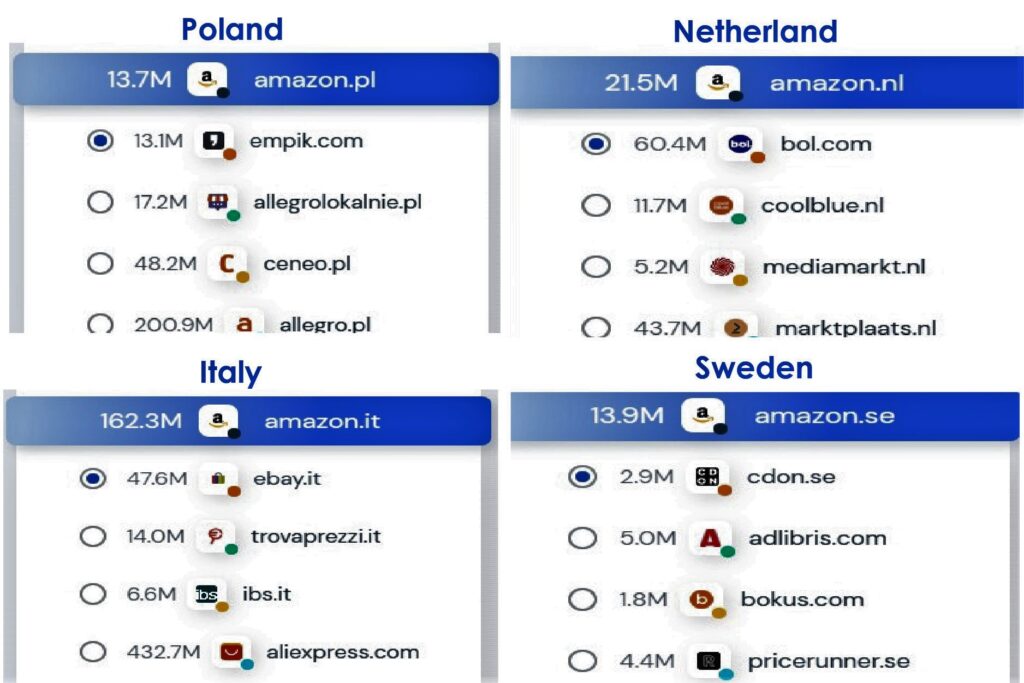
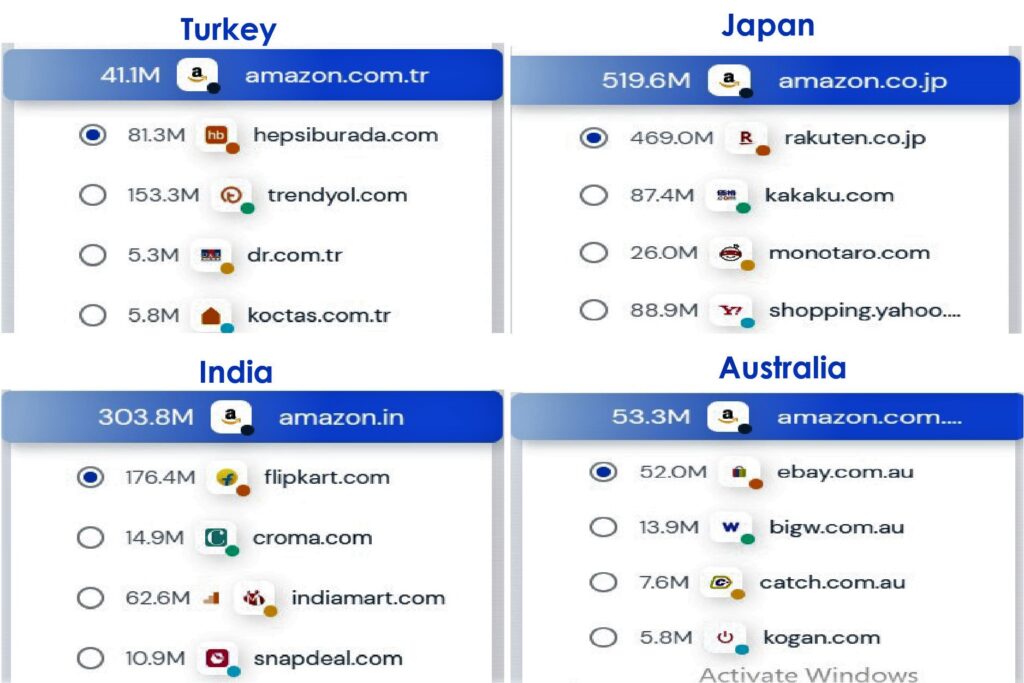
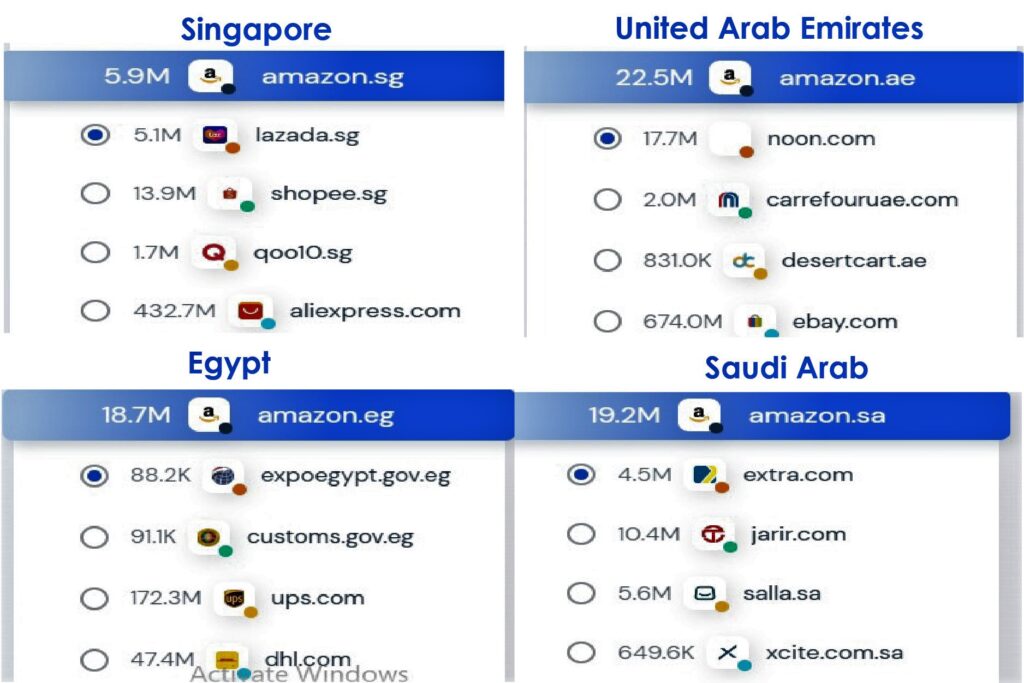
Requirements for Global Selling on Amazon
There are no such requirements for global selling on Amazon as it does not require additional fees or information over what you have already provided to Amazon while account opening.
Follow the below process to start global selling,
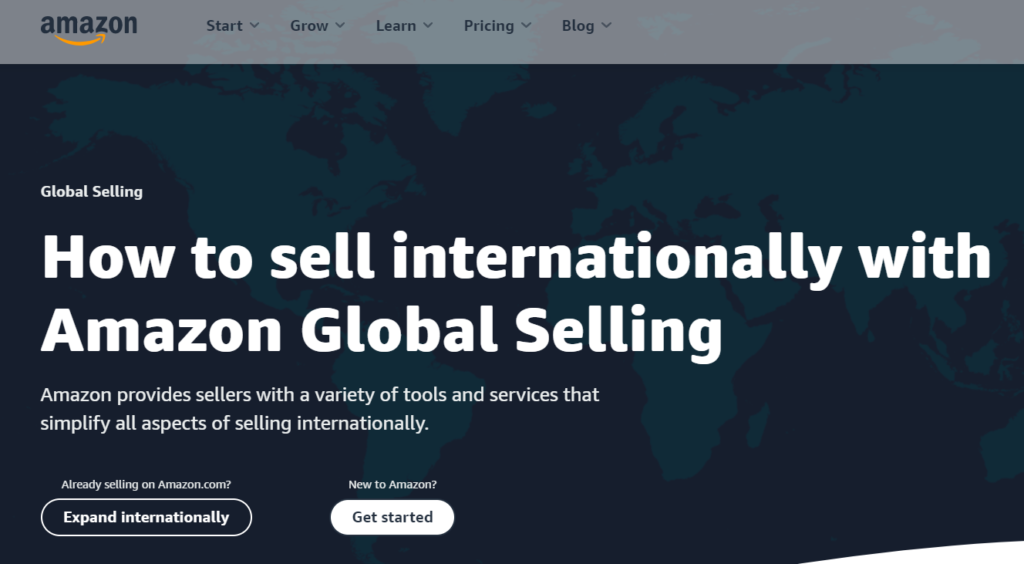
- Click on this link
- If you are already an Amazon Seller then click on the “Expand Internationally” button
- If you are a non-Amazon Seller then click on the “Get Started” button
- Decide which region to sell in and what product you want to sell
- Register in that region and list your products
- Ship your products to that region’s Amazon FBA or 3PL warehouse
- Manage your business yourself if you choose 3PL over Amazon FBA such as customer support, and local country returns, and use Amazon tools to optimize your sales from the data provided by seller central.
How to Sell Internationally on Amazon’s Global Marketplace?
Before deciding to sell internationally from Amazon’s global marketplace, you need to do the following,
Product Selection
Always remember that each product has its different demand in each country due to various factors such as
Cultural Preferences and Values
Cultural differences significantly impact consumer behavior and product demand.
For example, food preferences, clothing styles, and entertainment choices can vary greatly across cultures.
One ideal example is Amazon.in has different product demands than Amazon.com
Economic Development and Income Levels
Varying levels of economic development and income disparities across regions affect the demand for specific products.
For instance, regions with lower income levels may have greater demand for affordable and basic products.
Infrastructure and Logistics
The state of infrastructure, including transportation networks, distribution systems, and retail availability, can impact product demand in different regions.
Regulatory and Legal Factors
Regulatory frameworks and legal requirements differ across regions, leading to variations in product demand.
Different regions may have unique regulations on product safety, labeling, ingredients, and certifications. Compliance with these regulations can influence the availability and demand for specific products in each region.
Environmental Factors
Environmental conditions and concerns can shape product demand in different regions.
For example, regions prone to extreme weather conditions may have a higher demand for weather-resistant clothing or durable construction materials. Additionally, regions with a strong focus on sustainability and eco-consciousness may drive demand for environmentally friendly products.
Local Competition and Market Dynamics
Each region has its own competitive landscape, with local brands and market players influencing product demand. Local preferences and brand loyalty can impact the demand for specific products, even if they face competition from global brands.
Geographical and Demographic Factors
Geographical and demographic characteristics can influence product demand. For instance, regions with a large urban population may have a higher demand for compact and convenient products.
Similarly, regions with specific demographic profiles, such as aging populations or a high proportion of young consumers, may exhibit unique demand patterns.
Technological Adoption and Infrastructure
The level of technological adoption and digital infrastructure varies across regions. Differences in internet connectivity, e-commerce penetration, and mobile usage can impact product demand.
Regions with high technology adoption may experience greater demand for technologically advanced products or digital services.
This is why you need to make sure that your product has the demand in that specific region. You can use Helium 10, Jungle Scout, or any other tool to check your product’s demand and competition.
Setting up Amazon Seller Account in your Selective Region
After product selection, you can start setting up your accounts in all the marketplaces where you need to sell your product. You can read this blog post on how to open an Amazon account and what should you consider while opening an Amazon account.
Begin by selling your products internationally, starting with the United States, and subsequently broaden your business to cater to a global customer base with Amazon’s global selling.
Setup your Product Listings in International Marketplace
Craft SEO product listings yourself if you can or use freelancers, or SEO native agencies for Amazon who has complete command of creating a winning product listing which is the main component of your Amazon business.
Setup Pricing and Shipping Options for Each Marketplace
Amazon sellers need to select pricing according to the competition in a specific marketplace and then choose shipping options such as FBA or FBM. If you choose FBM then you overburden yourself but sometimes it is better to choose 3rd party fulfillment services over FBA depending upon shipping rates.
Setup Variation of your Product
If your products have different variations but some variations do not have demand in that selective marketplace then you need to choose to omit that variation from that region.
Decide whether to Register your Brand in the Specific Region
You can continue selling your products with a brand registry in the new region but your products are at risk of hijacking if you do not register your brand in the new region.
Brand registry is required for every region if you need to save yourself from unauthorized seller’s attacks on your listing and enjoy the brand’s features on Amazon such as EBC content, Display ads, and more.
Finally Setup Shipment of items to Amazon or 3PL fulfillment Center
After you have setup everything then you just need to send the stock to your preferred warehouse whether it be the Amazon fulfillment center or a 3PL warehouse. It is about choosing FBA or FBM.
How Much Does it Cost to Register and Export Through Amazon Global Selling?
Register cost is one time cost when you are opening your Amazon account in a region such as the United States and you can get these details from this blog post “How to Create Account on Amazon as a Seller”.
However, keep these extra costs in mind when you choose to use Amazon’s global selling feature.
- Exporting and shipping products through Amazon Global Selling will incur different expenses such as customs duties, taxes, and shipping fees.
- For payment processing, Amazon applies a fee to handle transactions made by buyers, usually ranging from 1.5% to 2.9% of the overall transaction value.
- In specific countries, the sale of goods may be subject to Value-Added Tax (VAT) or Goods and Services Tax (GST). These taxes will differ in every region.
Amazon Fba International Shipping Rates?
You need to know about FBA international shipping rates so you can compare easily and choose to use FBM if you find a good shipping company in your selective region.
Please Note: Shipping costs for items within each product category differ depending on the item, shipment, and chosen shipping method.
Amazon collaborates closely with its carriers to ensure a competitive shipping experience for its customers. During checkout, the exact shipping charges are determined based on factors such as the number of items, item type, weight, and volume of all items in the cart.
Here are some estimated international shipping rates if you choose to use FBA as fulfillment.
| Region | Standard Shipping Per Shipment | Expedited Shipping Per Shipment | Priority Courier Shipping Per Shipment |
| Asia | starting from $5.99 | starting from $10.99 | starting from $13.99 |
| Australia | starting from $4.99 | n/a | starting from $14.99 |
| Canada | starting from $6.99 | n/a | starting from $13.99 |
| Caribbean | starting from $6.99 | starting from $13.99 | starting from $39.99 |
| Central America | starting from $9.99 | starting from $10.99 | starting from $18.99 |
| Chile | starting from $12.99 | n/a | starting from $22.99 |
| China | starting from $8.99 | n/a | starting from $12.99 |
| Colombia | starting from $8.99 | n/a | starting from $13.99 |
| Europe | starting from $9.99 | starting from $9.99 | starting from $11.99 |
| Hong Kong | starting from $4.99 | n/a | starting from $24.99 |
| Israel | starting from $10.99 | n/a | starting from $17.99 |
| Japan | starting from $2.99 | starting from $8.99 | starting from $18.99 |
| Mexico | starting from $6.99 | n/a | starting from $16.99 |
| New Zealand | starting from $6.99 | n/a | starting from $14.99 |
| Northern Africa and the Middle East | starting from $4.99 | starting from $18.99 | starting from $39.99 |
| Oceania | starting from $9.99 | n/a | starting from $20.99 |
| Republic of Korea | n/a | starting from $6.99 | starting from $10.99 |
| South America | starting from $10.99 | starting from $12.99 | starting from $15.99 |
| Sub-Saharan Africa | starting from $9.99 | starting from $14.99 | starting from $22.99 |
| United Kingdom | starting from $5.99 | n/a | starting from $9.99 |
If you need to look for specific shipping rates for that region then you can look in the local marketplace. For instance, if you need to look for shipping rates in the German marketplace then you need to check Amazon.de
If you find competitive rates from a local 3rd party fulfillment service provider then you can make an account there and switch from FBA to FBM for that specific region.





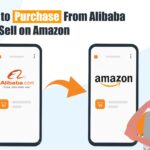

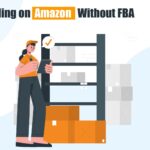

1 thought on “Unlock Global Markets: Selling Internationally on Amazon”
Informative post! Selling internationally on Amazon can open up great opportunities for businesses to expand their reach and tap into global markets. The tips and strategies shared in this blog post provide valuable insights on how to navigate the complexities of international selling on Amazon. Thanks for sharing these helpful tips!